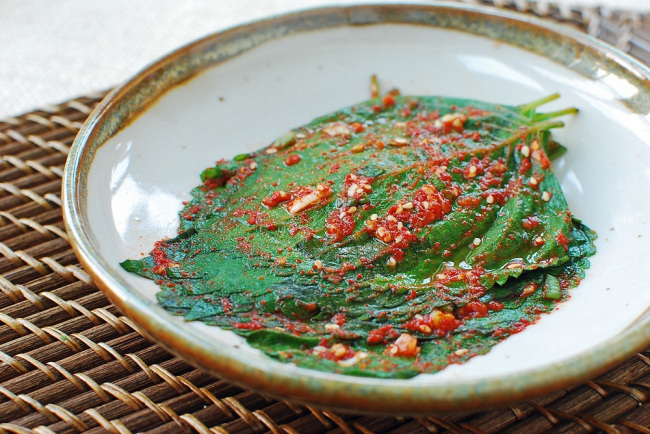
 Kkaennip is a fragrant herb that is widely used as a vegetable in Korean cuisine. It is a variety of perilla, which is a member of the mint family, and has a distinct, robust flavor. The fresh leaves are usually used as ssam (wraps) for grilled meat or fish, or added to other dishes such as bibim guksu (spicy noodles), savory pancakes or jjigae (stews) for extra flavor. However, pickling kkaennip, either as jangajji or kimchi, is hugely popular in Korea. Kkaennip jangajji and kimchi are staple summer side dishes but also traditional ways to preserve this fragrant vegetable to be enjoyed during the off season. The jangajji version is typically pickled in soy sauce. Here’s how to make the kimchi version. Pick up a leaf with chopsticks and wrap a bit of warm rice in it to eat. It’s delicious!
Kkaennip is a fragrant herb that is widely used as a vegetable in Korean cuisine. It is a variety of perilla, which is a member of the mint family, and has a distinct, robust flavor. The fresh leaves are usually used as ssam (wraps) for grilled meat or fish, or added to other dishes such as bibim guksu (spicy noodles), savory pancakes or jjigae (stews) for extra flavor. However, pickling kkaennip, either as jangajji or kimchi, is hugely popular in Korea. Kkaennip jangajji and kimchi are staple summer side dishes but also traditional ways to preserve this fragrant vegetable to be enjoyed during the off season. The jangajji version is typically pickled in soy sauce. Here’s how to make the kimchi version. Pick up a leaf with chopsticks and wrap a bit of warm rice in it to eat. It’s delicious!Ingredients:
● 50 to 60 kkaennip (perilla leaves)
● 2 to 3 tablespoons gochugaru, Korean red chili pepper flakes
● 1 tablespoon fish sauce
● 1 tablespoon soup soy sauce (or use more fish sauce)
● 2 teaspoons minced garlic
● 1 teaspoon sugar
● 1 teaspoon roasted sesame seeds
● 1/2 cup water or dashima (dried kelp/kombu) broth
● (Boil a 5-cm piece of dashima in 1 cup of water for about 5 minutes and then cool with the dashima in it.)
Wash the kkaennip thoroughly under running water one at a time. Hold the stems together, and shake off the excess water.
Place them in a colander to dry or pat dry with a paper towel.
Mix all the seasoning ingredients, including the water (or dashima broth), well in a small bowl. Place 3 or 4 leaves at a time in a container with an airtight lid, and spread a teaspoon of the sauce all over. Repeat the process with the remaining leaves. Rotate the location of the stem of each batch to level the stack.
Pour any remaining sauce over the leaves when all the leaves are used up. Cover tightly with the lid. Let it sit at room temperature for a few hours and refrigerate. You can start enjoying it right away, but it will keep well for weeks.
By Ro Hyo-sun
For more recipes visit www.koreanbapsang.com.
-
Articles by Korea Herald




![[Herald Interview] 'Amid aging population, Korea to invite more young professionals from overseas'](http://res.heraldm.com/phpwas/restmb_idxmake.php?idx=644&simg=/content/image/2024/04/24/20240424050844_0.jpg&u=20240424200058)












![[KH Explains] Korean shipbuilding stocks rally: Real growth or bubble?](http://res.heraldm.com/phpwas/restmb_idxmake.php?idx=652&simg=/content/image/2024/04/25/20240425050656_0.jpg&u=)

